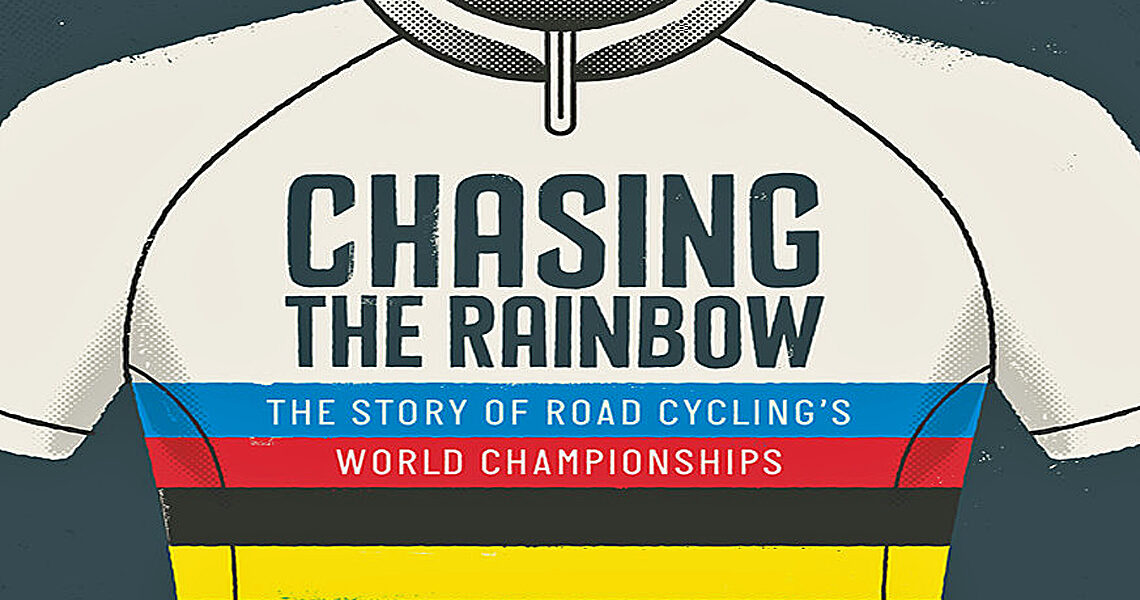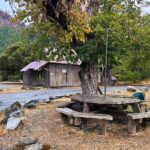Next week sees the cycling universe focused once again on the World Road Championships, with this year’s course being a challenging and beautiful route around Zurich. As a professional cyclist you don’t get a nice jersey for winning Milan-San Remo. Or Paris-Roubaix. Or the Tour of Flanders. Victory in the Clásica de San Sebastián entitles you to wear a big black beret that looks like a giant floppy pancake for a humiliating moment. But there is a very special jersey that, once you win it at a one day event, it is yours for a year wherever you race—the Spring Classics, the Tour, or the Meiji-Jingu Outer Garden University Criterium. This jersey, is of course, the glorious rainbow-striped confection first donned by Alfredo Binda in 1927. Its fascinating history is the subject of “Chasing the Rainbow: The Story of Road Cycling’s World Championships” by British author Giles Belbin.
Oddly enough, the idea of a Road World Championship was a long time in development. The UCI, created in 1900 following dissatisfaction over a British-led sanctioning organization, the ICI, did not get around to it until 1921, and even then it was strictly a time trial for amateurs only. It was felt that professionals did not really need this kind of event. Six years after the start of the amateur program, pros took to the race at the Nurbürgring auto racing circuit in a joint pro/amateur event, which seems weird in retrospect. The UCI came to its senses and the next year professionals and amateurs raced separately.
Marcel Kint – Valkenburg 1938
The author’s structure for the book is a summary of a number of races, followed by an interview with a pro cyclist who won the Rainbow Jersey, followed by more accounts of the races. The exception to this is an excellent conversation held with the grandson of Marcel Kint, the Belgian winner in 1938 who held the jersey for an unequalled eight years as the next race for it (in which he participated!) only took place in 1946 due to World War II. Marniek Kint runs the bike shop his grandfather established, after his retirement from his 16 year pro career, although in typical Belgian cyclist style he opened a small bar after his big win in 1938. Marcel Kint sounds like a true Flahute, the hard man so celebrated in Belgium’s cycling culture. “I was not exuberant, have never been a rider of many words. What did I have to say anyway? I laboured on the bike to have a better life and that’s all.” Yes, words spoken by the kind of guy who would win Paris-Roubaix during wartime (1943).
Benoni Beheyt – Ronse 1963
One of the attractions of the World Road Championship is the fact that it is held on a different course in a different country each year, allowing cyclists of all types a chance, whether they be sprinters or climbers or big gear grinders. It seems that for many years the idea of teams was anathema as the winning was seen as an individual achievement so there was the situation where you would have countrymen with you, wearing the same jersey, but not allowed to help you. Reality eventually set in and, as with the Tour de France, teamwork was eventually accepted as normal. This did not always mean that riders really understood this either as the book is filled with accounts of teammates working against each other and their nation’s interests. Although the book does not have many photos, the best one is from the 1963 race, where Rik Van Looy, receiving his silver medal on the podium, is glaring with undisguised menace at Benoni Beheyt, his teammate who chased him down and sprinted for the gold medal in Ronse, Belgium. Beheyt did not have much of a cycling career after that.
Tom Simpson – San Sebastián 1965
There are not a lot of Beneyts as wearers of the Rainbow Jersey, which instead has often gone to the greatest names in cycling, although two of them (Anquetil and Indurain) never managed better than second place. Anquetil may have ruined his own chances in order to ruin the chances of Raymond Poulidor, his eternal rival and teammate, while Indurain sacrificed himself to help Abraham Olano win in 1995. But then, Indurain had won the World Time Trial Championship shortly before, so he had something to take home already.
Eddy Merckx – Heerlen 1967, Mendrisio 1971, Montreal 1974
Only four male riders besides the current champion have won the Rainbow Jersey three times: Alfredo Binda, Rik Van Steenbergen, Oscar Freire and, of course, the titanic Eddy Merckx. Merckx did his third win on a hard 262 km course in Montreal over twenty-one laps, which included the 2.5 km climb up Mont Royal. His 1974 win not only brought him equal to Binda and Van Steenbergen but he became the first rider to win the Giro, the Tour and the Worlds in the same year, a feat only replicated once since when Stephen Roche did it in 1987.
Óscar Freire – Verona 1999, Lisbon 2001, Verona 2004
Three wins? Big deal! Another Belgian, Yvonne Reynders, won her Rainbow Jersey four times (exceeded by France’s Jeannie Longo, who managed it five times, along with four time trial wins) once women were allowed to compete from 1958 onwards. The interview with Renders and her friend Paul Van Bommels is pretty revealing of the state of things at the time. Van Bommel: “One year she rode sixty-four races and won sixty-one times, she was really outstanding. The parents of Yvonne had a coal shop and she delivered coal to their customers. She had a triporteur, you know what that is? It’s like a cargo bike, with a large area at the front to carry loads. She delivered 10 kg sacks of coal using it and she carried 24 sacks—240 kg of coal on the bike!…. Some people waned coal deliver to the fifth, sixth, seventh floor of buildings and to earn extra money she carried the coal up the stairs—there were no elevators so it was good training.” I bet it was.
Yvonne Reynders – Zandvoort 1959, Bern 1961, Renaix 1963, Nürburgring 1966
The first Women’s Champion in 1958 was from Luxembourg, incidentally. Popular Elsy Jacobs rolled into Reims three minutes ahead of the second place finisher. Her brothers were racers and she had borrowed their bikes to train and was soon racing and winning herself. After her win in 1958, she set the Women’s Hour Record of 41.437 kms at the Vigorelli Velodrome, a mark that stood for 14 years.
Luxembourg’s Elsy Jacobs – Reims 1958
Unsurprisingly, the author has a British focus and the accounts of British champions are well done. There is an interview with the sympathetic Barry Hoban about the first British pro champion, Tom Simpson, and a great deal about the force-of-nature who was Beryl Burton (voted Britain’s Best All-round Cyclist for 25 consecutive years). Burton never turned professional but given the era she lived in it is hard to see how that really would have been possible for her, or some of the other women mentioned in the book. Yvonne Renders was at a trade school during the day and trained in the evening. Beryl Burton picked rhubarb on a farm but still managed to win the Worlds twice and the World Pursuit Championship on the track five times (to say nothing of no fewer than 80 national titles). Britain’s most recent winner of the Rainbow Jersey on the road was Mark Cavendish in 2011.
Britain’s Mark Cavendish – Copenhagen 2011
Mario Cipollini gets a mention as a member of a national team that was notorious for infighting but was unbeatable when it could pull itself together. Under team manager Franco Ballerini the Italians managed consecutive victories between 2002 and 2008 but nothing since in an event in which Italians won for many years, often alternating with Belgian winners. The last of those was Tom Boonen, capping a most excellent year in 2005 in Madrid.
Tom Boonen – Madrid 2005 and Palolo Bettini – Saltzburg 2006, Stuttgart 2007
One of the only three-time winners interviewed in the book is Óscar Freire, whose excellent win in Verona in 1999 was unexpected as he was not well-known and none of the favourites made an attempt to chase him down after his brilliantly-executed escape. He not only went on to win two more times (including again in Verona on a different course) but had an excellent palmares, including three Milan-San Remo wins and the Green Jersey in the 2008 Tour de France.
Of course, the other three-time winner interviewed is Marianne Vos, “perhaps the most complete rider in history, with multiple world titles across road, cyclo-cross and track cycling and Olympic gold on road and track.” Her appearances at the World Road Championships have netted no fewer than eight podium places, including three on the top step. With her resurgent career in 2019, she has been considered amongst the favourites yet again.
Of course, by Sunday we will known who won the Women’s Elite race but it is nice to give a nod to Marianne Vos anyway!
Marianne Vos – Saltzburg 2006, Limburg 2012, Florence 2013
The chapter on the World Time Trial Championships seems like an afterthought but it has only existed since 1994 and the drama of this race, which is not so dramatic to most people anyway, is that in its history only four male riders have been responsible for 13 wins!
Peter Sagan – Richmond 2015, Doha 2016, Bergen 2017
“Chasing the Rainbow” offers cycling history at its best, personal reflections on the careers of those who were in the races and stories—some familiar, many less so—that illustrate why the race with the special jersey is so special, and so unpredictable, itself.
“Chasing the Rainbow: The Story of Road Cycling’s World Championships”
by Giles Belbin
Foreward by Brian Cookson (Former President of the UCI)
304 pp., 8 pages of illustrations, hardcover
Quarto Publishing, London, 2017
ISBN 978-1-78131-631-3
• BUY “Chasing the Rainbow” at AMAZON.COM.
# Stay PEZ for all the results from the 2024 World championships in Zurich. #
The post PEZ Bookshelf: Chasing the Rainbow appeared first on PezCycling News.




